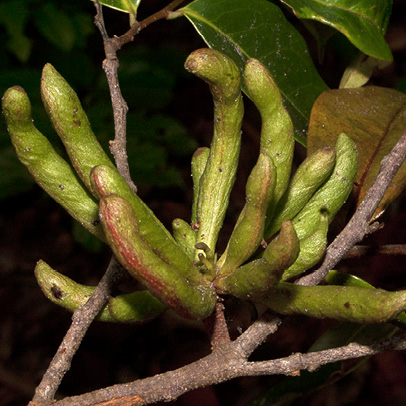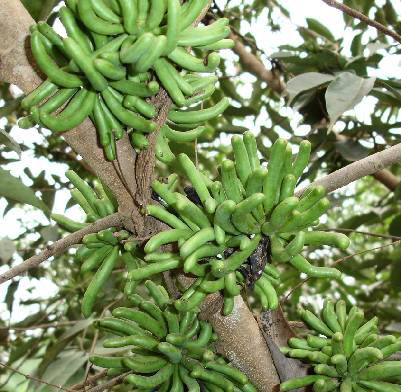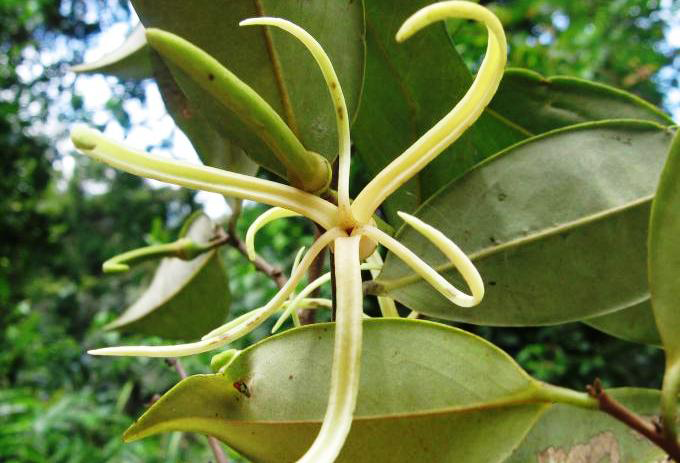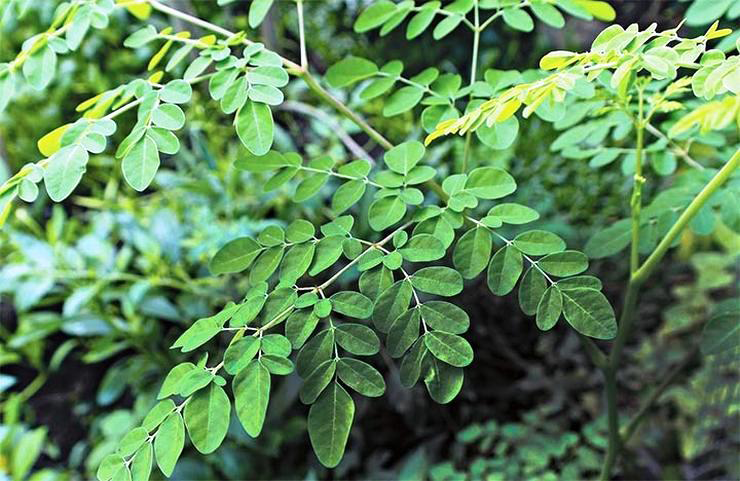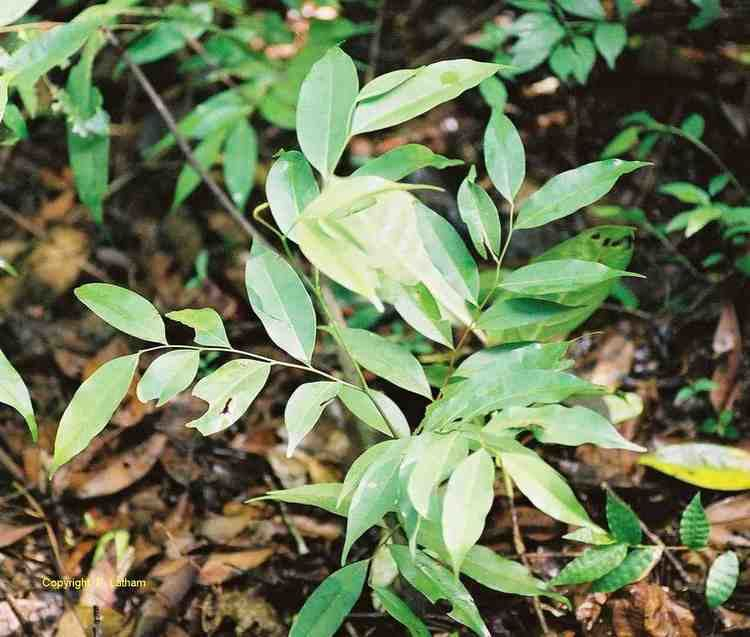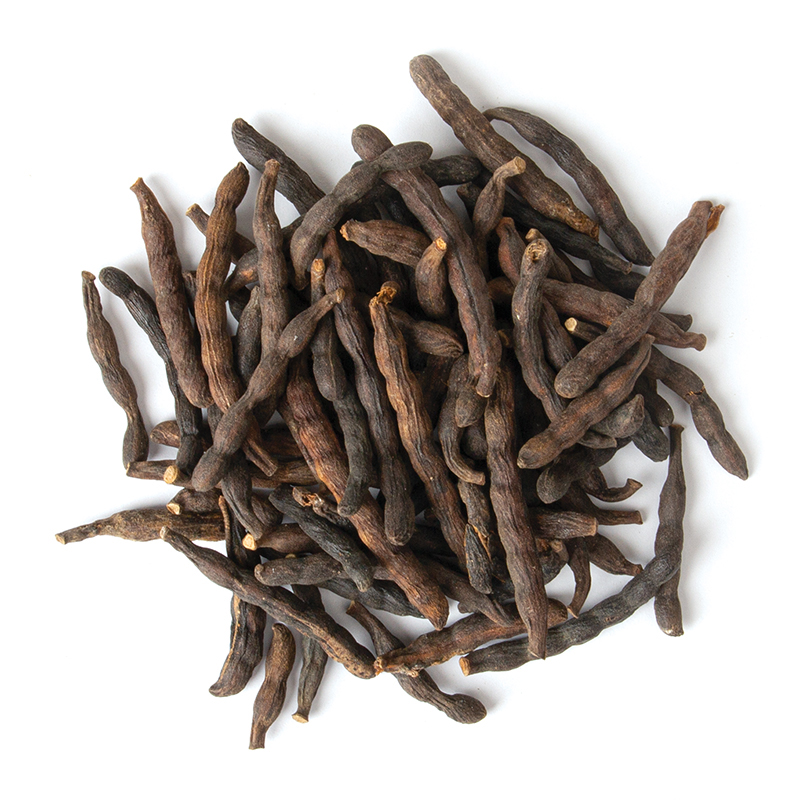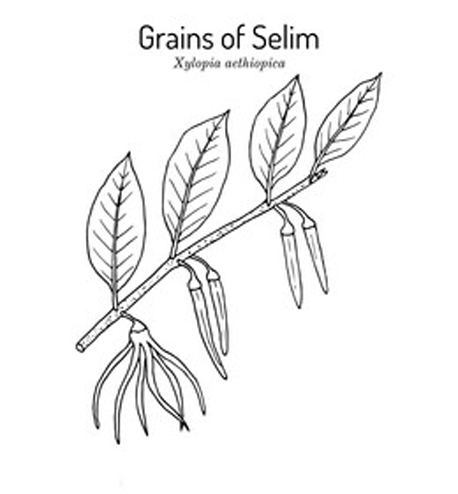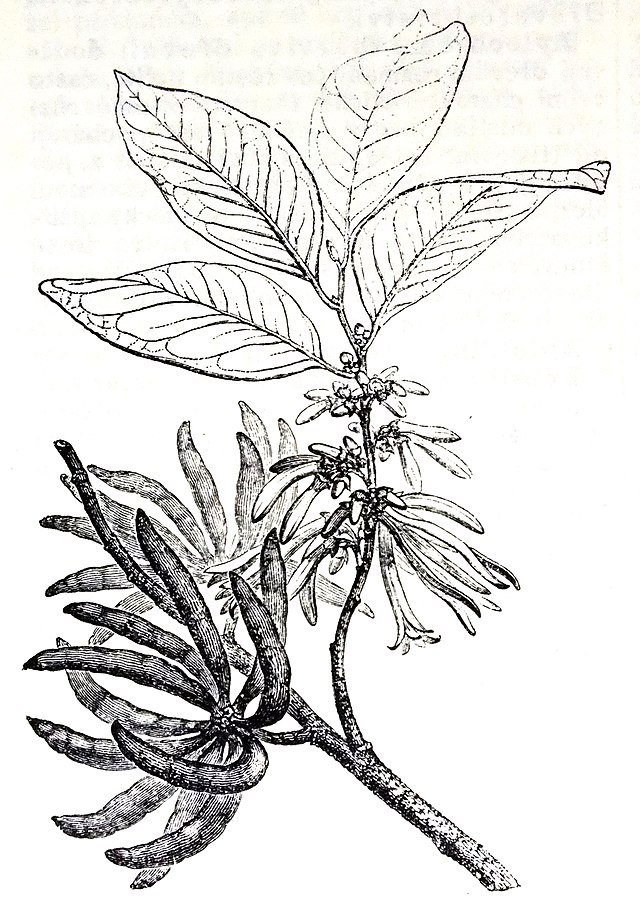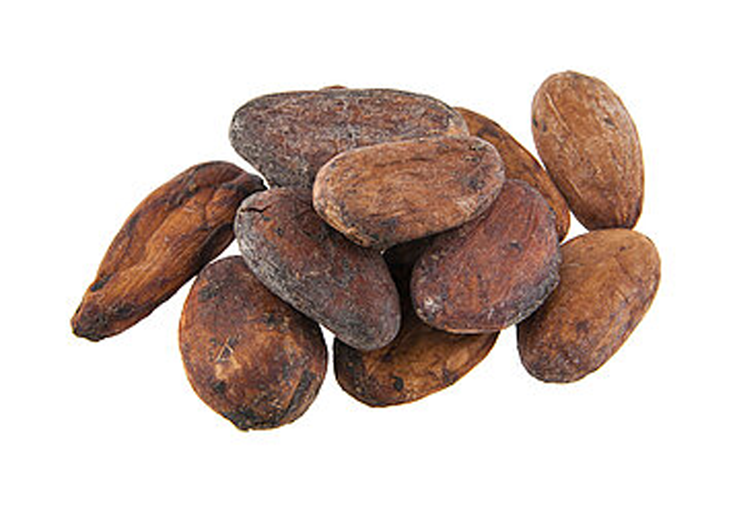Ethiopian pepper is a multipurpose tree that is very important in the local economy, supplying foods, a wide range of medicines, wood and many other commodities. The fruit was at one time exported to Europe. It remains an important item of trade throughout parts of Africa, sold in local markets as a spice and medicine. The tree is often cultivated near villages and is often protected when growing in the forest. It is also sometimes planted as an ornamental and to provide shade. Negro pepper has been used as a pepper substitute in Europe, but with regular imports of black pepper from India starting in the 16th century, it mostly disappeared. In later times, Negro pepper was only traded as a pepper substitute (or surrogate) in times of war and short supply; the last time, it was seen from after World War II till the 60ies of the previous century. It is now rarely available outside of the production countries.
Grains of Selim Facts
| Grains of Selim Quick Facts | |
|---|---|
| Name: | Grains of Selim |
| Scientific Name: | Xylopia aethiopica |
| Origin | Lowland rainforest and moist fringe forest in the savanna zones of Africa |
| Colors | Green when young turning to dark brown as they mature |
| Shapes | Small, twisted bean-pods. They are dark brown, cylindrical, 2.5 to 5 cm long and 4 to 6 mm thick. |
| Taste | sharp, pungent taste with a slightly bitter aftertaste |
| Health benefits | Beneficial for Malaria, Asthma, toothaches, diarrhea, dysentery, bronchitis, Menstrual Problems, Gastrointestinal Problems, Rheumatism, Respiratory System Diseases, and Dermatological Problems |
| Name | Grains of Selim |
|---|---|
| Scientific Name | Xylopia aethiopica |
| Native | Lowland rainforest and moist fringe forest in the savanna zones of Africa, but largely found in West, Central and Southern Africa |
| Common Names | lowland rainforest and moist fringe forest in the savanna zones of Africa, but largely found in West, Central and Southern Africa |
| Name in Other Languages | Arabic: Fulful alsudan (فُلْفُل السُّودَان) , marat alkhashab alhabashia (مرة الخشب الحبشية) Hab az-Zelim, Hab al-Zelim Czech: Habzelie etiopská Dutch: Granen van Selim English: African grains of Selim, Ethiopian pepper, Grains of Selim, Kani pepper, Moor pepper, Negro pepper, Senegal pepper, spice tree, Many red-fingers, African pepper Estonian: Etioopia ksüloopia French: Graines de selim, Graine de sélim de l’Ethiopie, Kili, Piment noir de Guinée, Poivre de Guinée, Poivre du Senegal, Selim, Poivre d’Ethiopie, Piment noir de Guinée Fulah: Kimbaare German: Kanipfeffer, Mohrenpfeffer, Negerpfeffer, Selimskorner, Senegalpfeffer, Guinea-Pfeffer, Kumba-Pfeffer, Malaguetapfeffer Greek: Afrikaniko piperi (Αφρικάνικό πιπέρι) Hausa: Kimba Hungarian: Arabbors, Borsfa Igbo: Uda Italian: Pepe di Guinea Japanese: Kishiropia (キシロピア), Afurika kishiropia (アフリカ キシロピア), Giniapeppāgurōbu (ギニアペッパーグローブ) Korean: Keu sil lo pi a (크실로피아) Lithuanian: Juodieji pipirai Polish: Pieprz murzyński Portuguese: Malagueta-de-guiné, Malagueta-preta, Pimenta-da-Ãfrica, Pimenta-do-congo, cabela, pimenta-da-etiópia, pimenta-da-guiné, pimenteira-da-etiópia, pimenteira-da-guiné Russian: Kumba perets (Кумба перец), Mavritanskij perets (Мавританский перец) Spanish: Maniguete, Pimienta de EtiopÃa, Pimienta de Guinea, Pimienta de los negros Yoruba: Eeru, Eerunje, Olorin |
| Plant Growth Habit | Tall, slim, evergreen aromatic shrub or tree |
| Growing Climates | Lowland rainforest, coastal brackish swamps, littoral formations, deciduous and fringing forests, swamp forest, riverine and fringing forest |
| Plant Size | 50 to 100 feet (15 to 30 metres) tall, with a trunk 24 to 28 inches (60 to 70 cm) wide |
| Bark | Bark grey-brown, smooth or finely vertically fissured and peeling easily |
| Branchlets | Young branchlets are puberulous at first, but soon glabrous, reddish-brown to blackish, smooth or rugose and mostly with many conspicuous lenticels |
| Leaf | Leaves simple, alternate, oblong, elliptic to ovate, 8-16.5 by 2.8-6.5 cm, leathery, bluish-green and without hairs above, but with fine brownish hairs below, margin entire, and glabrous; petiole 0.3-0.6 cm, thickset and dark-coloured |
| Flowering season | Occurs twice annually
|
| Flower | Flowers are bisexual, solitary or in 3-5 flowered fasicles or in strange, sinuous, branched spikes, or cymes, up to 5.5 by 0.4 cm and creamy-green |
| Fruit Shape & Size | Small, twisted bean-pods. They are dark brown, cylindrical, 2.5 to 5 cm long and 4 to 6 mm thick; the contours of the seeds are visible from outside |
| Fruit Color | Green when young turning to dark brown as they mature |
| Seed | Seeds black, 5-8 per pod, kidney-shaped seeds of approximately 10 mm length with a yellow papery aril. The hull is aromatic, but not the seed itself |
| Taste | Sharp, pungent taste with a slightly bitter aftertaste |
| Plant Parts Used | Seed, stem bark, root bark |
| Season | Occurs twice in
|
| Health Benefits |
|
Plant Description
A grain of Selim is a tall, slim, evergreen aromatic shrub or tree that normally grows about 50 to 100 feet (15 to 30 meters) tall, with a trunk 24 to 28 inches (60 to 70 cm) wide. The plant is found growing in lowland rainforest, coastal brackish swamps, littoral formations, deciduous and fringing forests, and swamp forest, riverine and fringing forest. The plant has straight stem, many-branched crown and sometimes buttressed. Young branchlets are puberulous at first, but soon glabrous, reddish-brown to blackish, smooth or rugose and mostly with many conspicuous lenticels. Bark is grey-brown, smooth or finely vertically fissured and peeling easily.
Leaves
Leaf-blades are oblong, elliptic, ovate or oblanceolate, 8–16.4 cm long, 2.8–6.5 cm. wide, obtuse, acute or prominently acuminate at the apex (the acumen attaining 2 cm.), cuneate to rounded and decurrent at the base, coriaceous, drying bluish-green above and greenish-brown to orange beneath, glabrous above, adpressed pubescent or glabrescent (silky pilose when very young) and usually ± glaucous beneath; venation laxly to densely reticulate, usually prominent on both surfaces but sometimes obscure above; petiole 3–6 mm. long, blackish, adpressed pubescent or glabrescent.
Flowers
Flowers are solitary or in 3–5-flowered fascicles, fragrant; pedicels 0.4–1.1 cm. long, adpressed ferruginous pubescent; bracteoles 2–3, cucullate, 1–4 mm. long, 2–2.5 mm. wide, adpressed pubescent outside, glabrous inside. Sepals are ovate-triangular, 3–5 mm. long and wide, rounded to acute or apiculate, glabrescent to pubescent outside, glabrous inside. Petals are cream, greenish-white or yellow; outer linear, 2.5–5.5 cm. long, 2–3.5 mm. wide above, 5–6 mm. wide at the base, concave at the base, silky pubescent outside, tomentellous inside save at the base; inner rather shorter and narrower, 2.7–4.5 cm. long, 1.5–2 mm. wide, tomentellous save at the base. Stamens are linear, 1–1.5 mm. long; connective-prolongation obliquely capitate, papillose or pubescent. Carpels are 24–32(–42); ovary cylindric, 1–1.5 mm. long, sparsely adpressed pilose, 6–8-ovuled; styles linear-tapering, aggregated to form a very narrow cone ± 3–4.5 mm. long.
Fruits
Fertile flowers are followed by small, twisted bean-pods. They are dark brown, cylindrical, 2.5 to 5 cm long and 4 to 6 mm thick; the contours of the seeds are visible from outside. Each pod consists of 5 to 8 kidney-shaped seeds grains of approximately 5 mm length. The hull is aromatic, but not the grain itself. The dried fruits of X. aethiopica (grains of Selim) are used as a spice and an herbal medicine.
Health benefits of Grains of Selim
There are so many health benefits of Grains of Selim seed, based of its rich phytochemical composition and nutritional value. Listed below are some of the well-known health benefits of Grains of Selim
1. Cure Dermatological Problems
Grains of Selim seeds are proven to be a great remedy for treating skin conditions, including boils, itches and skin eruptions.
2. Treats Respiratory System Diseases
Researches have revealed that the bark of Grains of Selim consists of some powerful properties, which are very effective in treating respiratory system diseases like common cold, bacterial pneumonia, asthma and bronchitis.
To shield yourself against such diseases, it is best you avoid exposing yourself to harmful environmental substances, such as tobacco smoke, dust, chemicals, vapors, fumes, etc. When you inhale too much of this, it may trigger inflammation in your lungs, which may, in turn, lead to an infection.
3. Treat Rheumatism
Also known as rheumatic disorders, Rheumatism is an umbrella term for diseases that cause chronic pain and inflammation in the joints, muscles, or connective tissue. If in case you are battling with this disorder, bark of Grains of Selim tree has anti-arthritic, antipyretic and anti-inflammatory properties that can be used in treating a myriad of rheumatic disorders, including arthritic pain.
4. Relieves Gastrointestinal Problems
Gastrointestinal disorders are health conditions affecting the gastrointestinal tract [oesophagus, stomach, rectum, small and large intestine]. This includes stomach ache, irritable bowel syndrome, dysentery, gastric ulcers, indigestion, flatulence, etc. The leaves of Grains of Selim are found to be aseptic in nature, meaning that they are capable of relieving the aforementioned internal disorders.
5. Treat Menstrual Problems
There are quite a few issues associated with menstruation. Some reports have claimed that Grains of Selim may be useful in treating menstrual issues. Seed of Grains of Selim when dried are normally used in traditional medicine for enhancing menstrual blood flow, and for treating amenorrhea.
6. Cure bronchitis
Grains of Selim have been known to be effective in treatment of bronchitis. It is used as a natural treatment in Africa for treating acute cases of this disease by consuming it in the form of decoction.
7. Helps in treatment of dysentery
The anti-bacterial effect of this herb has been known to be effective in killing bacteria present in the stomach and the intestines. This property thus helps it in acting as a cure to digestive issues such as dysentery and diarrhea.
8. Helpful in case of toothaches
The anti-bacterial property of this herb makes it useful for use as an herbal remedy against toothache. It is known to be used as an active ingredient in mouthwash which helps in maintaining oral health.
9. Helpful in Asthma
Asthma is one of the most common respiratory issues. This herb tends to helps in curing the triggers which encourage these issues and thus reduce the chances of asthma.
10. Fight Malaria
It has anti-malaria properties and so can be used in herbal drugs to prevent and treat and prevent malaria.
11. Has Anti-spirochetal Properties
Grains of Selim has anti-spirochetal properties therefore are potentially useful in treating syphilis, yaws and other related diseases.
12. Has Anti-fertility Properties
It can be used as a contraceptive or birth control tool to help reduce the chances of getting pregnant. Therefore controls the spacing of your children.
Traditional uses and benefits of Grains of Selim
- Fruit-extract or decoction of the bark is useful in the treatment of bronchitis and dysenteric conditions, and also as a medicine for biliousness and febrile pains.
- In Congo bark is steeped in palm-wine which is given for attacks of asthma, stomach-aches and rheumatism at the rate of one or two glasses per day.
- Concentrated root-decoction is used as a mouthwash for toothache in the Casamance of Senegal.
- Powdered root is used as a dressing for sores and to rub on gums for pyorrhea and in local treatment of cancer in Nigeria.
- The powdered bark is dusted onto ulcers.
- Decoction of leaves and roots is a general tonic in Nigeria for fevers and debility, and enters an agbo prescription.
- Decoction is used in Gabon against rheumatism and as an emetic, and as a macerate in palm-wine it makes a popular intoxicating drink.
- In Congo powdered leaves are taken as snuff for headaches, and used in friction on the chest for bronchio-pneumonia.
- Leaf-sap mixed with kola nut is given at the time of epileptic fits, and the fruit is used to season the patient’s food.
- Smoke from a mixture of dried pulped fruit and tobacco is inhaled to relieve respiratory ailments in Liberia.
- Fruits are particularly recommended to women who have newly given birth as a tonic in the Ivory Coast where they are also used as an anthelmintic.
- They are often included in preparations for enemas and external uses calling on its revulsive properties for pains in the chest, sides, ribs etc., and generally for any painful area, lumbago, neuralgia and in the treatment of boils and skin eruptions.
- As a woman’s remedy it is taken to encourage fertility and for ease in childbed.
- In combination with Newbouldia laevis was used for inducing or increasing menstrual flow, and was accordingly deemed to have abortifacient properties.
- Crushed they are rubbed on the forehead for headache and neuralgia, or a poultice of leaves and fruit may be applied.
- In S Nigeria Igbos grind the seed and give it to lactating mothers, and the Edo of Uzalla (Benin) use the seed (probably of this plant) as an ingredient of a medicine to aid conception.
- An extract of the seeds is also taken as a vermifuge for roundworms, and as an emetic for biliousness.
- Bark stepped in Palm Wine is used to treat Asthma, Stomach ache and Rheumatism.
- Root is used as a mouthwash for Toothaches.
- Powdered form of root is used externally as a dressing for sores, gingivitis and in the local cancer treatment.
- Decoction of leaves and roots is used as a tonic to treats fever and debility.
- The ground seed increases the milk flow in lactating mothers.
- It is used traditionally to treat female infertility, hemorrhoids, uterine fibroid, malaria, amenorrhea, cough, syphilis, diabetes, and dysentery among others.
- Seeds specifically are crushed and topically applied on the forehead to treat neuralgia and headache.
- Seeds when taken as a decoction or chewed treat epilepsy, numbness, and anemia.
- Seeds are also known to be used traditionally to enhance postpartum placental expulsion.
- Powdered root, mixed with salt, is used as a cure for constipation.
- Regular consumption of Negro pepper promotes weight loss to ensure a healthy weight control.
- It is use as natural contraceptive to control spacing of children by boiling the seeds with only water, take the solution after sexual intercourse.
- Regular consumption of Negro pepper is healthy for treating gastric ulcer.
- It is good for combating respiratory discomforts like Pneumonia, Bronchitis and Asthma.
Other Facts
- Grains of Selim are used extensively in construction, African cuisine and traditional medicine.
- The bark is used to make doors and partitions, and in Gabon to wrap around torches.
- Wood is used for purposes requiring resilience such as boat-construction, masts, oars, paddles and spars.
- In Togo and Gabon it is used for bows and crossbows for hunters and warriors.
- Wood is resistant to termite attack and is used in hut-construction for posts, scantlings, roof-ridges and joists.
- It burns with a hot flame and has found use as a steamboat fuel.
- The root-wood can be used as a cork.
- The fruits are smoked like tobacco in Sierra Leone.
- The fruit, ground up with Capsicum peppers, is mixed with kola nuts as a repellent for the Kola weevil.
- Seeds, as separate from the fruit, are a substitute for pepper, and have cosmetic, revulsive and stimulant uses.
- Mixed with other spices they are rubbed on the body as a cosmetic and scent, and are commonly used as a perfume for clothing.
- Fruit is occasionally put into jars of water for purification purposes.
- Crushed, powdered fruit mixed with shea butter and coconut oil is used as creams, cosmetic products and perfumes.
- The tree provides a good shade.
Side effects of Grains of Selim
Listed below are few of the side effects of Grains of Selim
1. Male Infertility
Grains of Selim have a negative effect on sperm count and reduction in motility which may lead to secondary infertility. According to a study in the international Journal of Scientific Research, prolonged intake of Grains of Selim can lead to reduction in sperm count and reduction in motility which may lead to secondary infertility.
2. Toxic to the Liver and Kidney
Liver and the kidneys are some of the most essential and hardworking organs in the body. They carry out numerous functions such as excretion of waste, metabolism of many substances, hormonal regulation, and proper digestion, as well as proper coagulation. Research has shown that despite its many beneficial effects, Grains of Selim can be toxic. Findings from a study revealed that aqueous extract of Grains of Selim possess some toxic effect on the liver and kidney. Indiscriminate ingestion of the extract of Grains of Selim should be avoided.
3. Can cause Abortion
Menstrual cycle is the hormonal process a woman’s body goes through each month to prepare for a possible pregnancy. Regular menstrual periods in the years between puberty and menopause are usually a sign that your body is working normally. Irregular or heavy, painful periods are not normal. Grains of Selim can alter the normal pattern of a woman’s monthly flow. According to research alterations in the estrous cycle, specifically, with prolonged diestrus, reductions in ovulation levels and implantation, as well as, abortifacient effect. Dietary Grains of Selim could be a good candidate for consideration as an oral contraceptive agent.
References:
https://www.itis.gov/servlet/SingleRpt/SingleRpt?search_topic=TSN&search_value=506195#null
https://gd.eppo.int/taxon/XYPAE
http://www.theplantlist.org/tpl1.1/record/kew-2468107
https://plants.jstor.org/stable/10.5555/al.ap.upwta.1_296
https://powo.science.kew.org/taxon/urn:lsid:ipni.org:names:76056-1
https://en.wikipedia.org/wiki/Xylopia_aethiopica
http://apps.worldagroforestry.org/treedb/AFTPDFS/Xylopia_aethiopica.PDF
https://tropical.theferns.info/viewtropical.php?id=Xylopia+aethiopica
https://plants.usda.gov/home/plantProfile?symbol=XYAE



